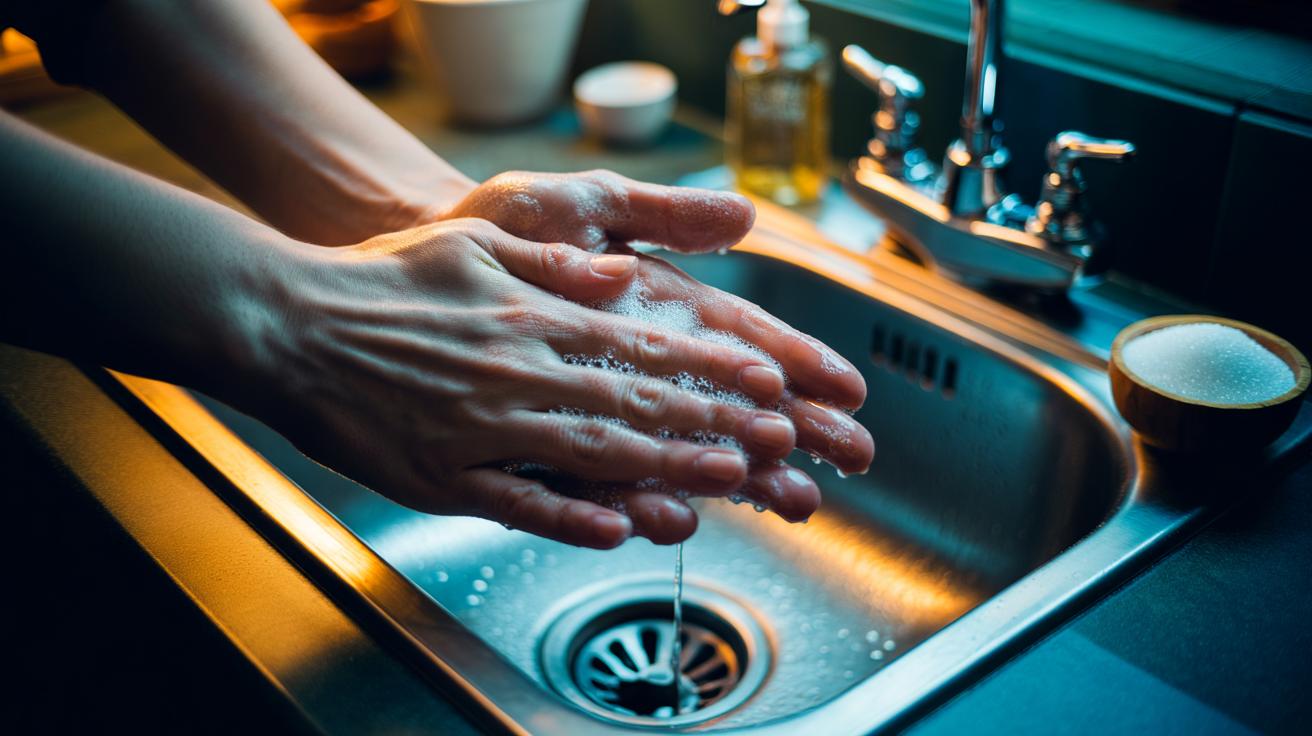In a nutshell
- 🧼 Soap-and-sugar synergy: surfactants form micelles to lift oils while dissolving sugar provides controlled abrasion that frees grime from skin creases safely.
- 📝 How-to in seconds: mix 1 tsp liquid soap with 1–2 tsp sugar, rub gently for 20–30 seconds with a touch of warm water, then rinse and apply a moisturiser or barrier cream.
- ⚖️ Pick the right grit: granulated sugar for general grease, caster sugar for sensitive skin; avoid coarse demerara; use pumice sparingly; salt and coffee can sting or stain.
- 🧤 Skin-first care: limit abrasive scrubs to once or twice daily, skip on broken skin, and choose fragrance-free products if prone to eczema; seek advice for persistent irritation.
- 🌍 Practical and eco-friendlier: inexpensive, microplastic-free method that tackles kitchen oil and workshop grime while preserving the skin barrier when used correctly.
Grease, cooking oil, engine residue, cycle-chain lube: few substances cling to skin as stubbornly. Yet a simple pairing found in most UK homes—the soap-and-sugar scrub—cuts through build-up without harsh solvents or microplastics. Soap’s surfactants loosen slick films, while sugar’s fine crystals provide controlled abrasion that lifts grime out of fingerprints and nail folds. Because sugar dissolves as you work, the scrub softens in real time, limiting over-scrubbing and preserving the skin’s barrier. This method is cheap, rapid, and gentle when used correctly. Below, the science and the method: how to combine chemistry and texture to remove oil safely, and what to choose when hands are seriously dirty.
Why Soap and Sugar Work Together
Soap molecules are amphiphilic: one end loves water, the other loves oil. When you lather, these surfactants surround hydrophobic oils and form micelles, tiny spheres that trap grease so it rinses away. Where heavy deposits resist lather alone—think fryer fat, car grease, or bicycle lubricants—granulated sugar adds mechanical lift. The fine crystals scour the oil film, exposing fresh surface area so surfactants can bind. The duo accelerates removal while letting you use less soap and less force. Because sugar dissolves quickly in warm water, the scrub “self-dials” from gritty to smooth within seconds, easing off before skin gets abraded.
Texture matters. Standard white granulated sugar has uniform, angular crystals that bite gently; caster sugar is milder for sensitive hands; demerara is too coarse for most palms. Unlike salt, sugar doesn’t sting intact skin as readily and won’t etch micro-cuts as aggressively. It also avoids the environmental issues tied to plastic microbeads. Warm—not hot—water improves flow and rinse-off without stripping the skin’s natural lipids. Finish with a light moisturiser to keep the barrier supple after cleansing.
How to Mix and Use the Scrub, Step by Step
– Dispense 1 teaspoon of liquid hand soap or a small dab of dishwashing liquid into your palm. Sprinkle 1–2 teaspoons of granulated sugar on top. With dry hands, rub palms together to form a paste, then add a few drops of warm water. Work the scrub over knuckles, nail beds, and creases for 20–30 seconds. Let the sugar do the work—don’t grind hard. As crystals melt, grease will loosen and the paste will turn cloudy as micelles load with oil.
– Rinse thoroughly, rubbing as you go so the last crystals sweep out residual grime. Repeat once for heavy contamination. Pat dry and apply an unscented barrier cream or moisturiser. For very sensitive skin, swap to caster sugar and a gentle, fragrance-free hand wash. Do not use on broken skin or active dermatitis. Skip add-ins like lemon juice or essential oils if you have cuts—they sting and can irritate. If you’ve handled petrol, paints, or harsh solvents, cleanse promptly in a ventilated space and avoid mixing chemicals on skin.
Choosing the Right Abrasive and Avoiding Skin Damage
The best scrub is the one that clears grime without stripping your barrier. Sugar provides controlled abrasion that fades as it dissolves, which limits over-exfoliation. Salt scrubs can cut and sting. Coffee grounds add grip but can stain and clog drains. Pumice creams tackle stubborn engine grease yet risk micro-tears if overused. Match the grit to the job, then moisturise to restore suppleness. If you scrub daily—mechanics, gardeners, chefs—apply a barrier cream before work and cotton or nitrile gloves where practical. Choose fragrance-free products if you’re prone to eczema.
| Abrasive | Texture/Action | Best For |
|---|---|---|
| Granulated sugar | Dissolving grit; gentle abrasion | Kitchen oils, light–moderate grease |
| Caster sugar | Finer, softer glide | Sensitive skin, frequent use |
| Salt | Sharper edges; stings | Short, tough jobs on intact skin |
| Coffee grounds | Fibrous scrub; may stain | Garden dirt, odour masking |
| Pumice | Aggressive, non-dissolving | Engine grime; use sparingly |
Limit abrasive scrubs to once or twice a day unless instructed otherwise by a clinician. If your hands burn or crack, scale back, switch to milder sugar and gentler soaps, and apply a ceramide-rich cream after washing. Persistent dermatitis, nailfold inflammation, or suspected infection warrants medical advice. For prevention, wipe tools promptly, degrease surfaces before they smear, and keep a small container of sugar near the sink so the solution is always to hand.
The soap-and-sugar scrub works because chemistry and texture cooperate: surfactants loosen oil, and dissolving sugar crystals lift it safely from the skin’s micro-topography. It’s quick, inexpensive, and kinder to hands than many harsh degreasers when you choose the right grit and protect the barrier afterwards. Rinse thoroughly and moisturise—small habits keep hard-working hands resilient. Whether you’re cleaning up after a Sunday roast or a bike repair, this method earns a permanent spot beside the sink. How will you adapt the scrub—sugar type, soap choice, protective creams—to fit your kitchen or workshop routine?
Did you like it?4.4/5 (25)
